Business Environment Analysis and Sustainability
VerifiedAdded on 2020/10/04
|12
|4189
|385
AI Summary
The given report is a detailed analysis of the business environment, aiming to attain long-term profitability. Every business differs in size, operations, scope, structure, and accordingly runs its business to achieve sustainability. The organization must analyze macroeconomic factors through PESTLE analysis and Porters five factor model, along with internal factors using SWOT analysis. This helps identify opportunities and overcome threats faced by the company.
Contribute Materials
Your contribution can guide someone’s learning journey. Share your
documents today.
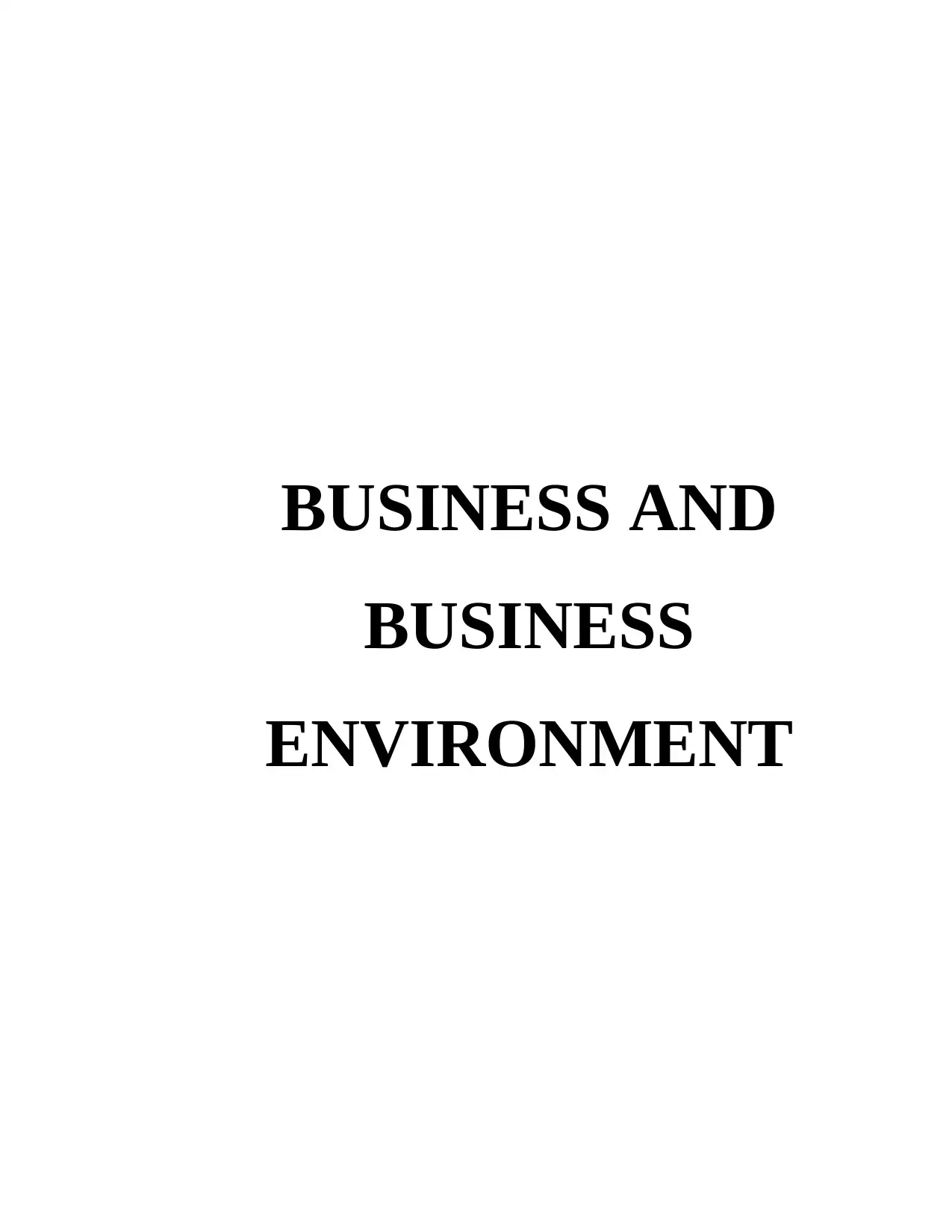
BUSINESS AND
BUSINESS
ENVIRONMENT
BUSINESS
ENVIRONMENT
Secure Best Marks with AI Grader
Need help grading? Try our AI Grader for instant feedback on your assignments.
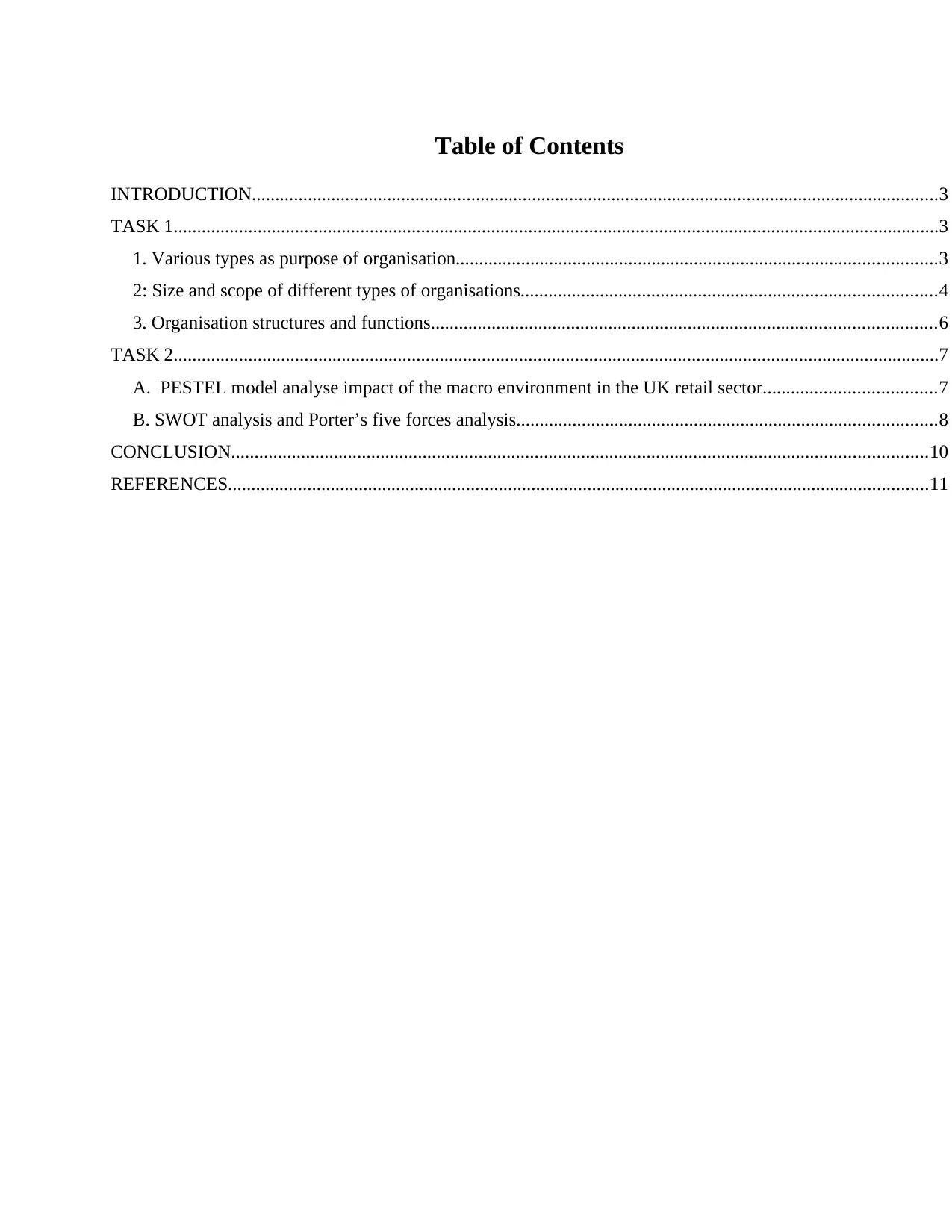
Table of Contents
INTRODUCTION...................................................................................................................................................3
TASK 1....................................................................................................................................................................3
1. Various types as purpose of organisation.......................................................................................................3
2: Size and scope of different types of organisations.........................................................................................4
3. Organisation structures and functions............................................................................................................6
TASK 2....................................................................................................................................................................7
A. PESTEL model analyse impact of the macro environment in the UK retail sector.....................................7
B. SWOT analysis and Porter’s five forces analysis..........................................................................................8
CONCLUSION.....................................................................................................................................................10
REFERENCES......................................................................................................................................................11
INTRODUCTION...................................................................................................................................................3
TASK 1....................................................................................................................................................................3
1. Various types as purpose of organisation.......................................................................................................3
2: Size and scope of different types of organisations.........................................................................................4
3. Organisation structures and functions............................................................................................................6
TASK 2....................................................................................................................................................................7
A. PESTEL model analyse impact of the macro environment in the UK retail sector.....................................7
B. SWOT analysis and Porter’s five forces analysis..........................................................................................8
CONCLUSION.....................................................................................................................................................10
REFERENCES......................................................................................................................................................11
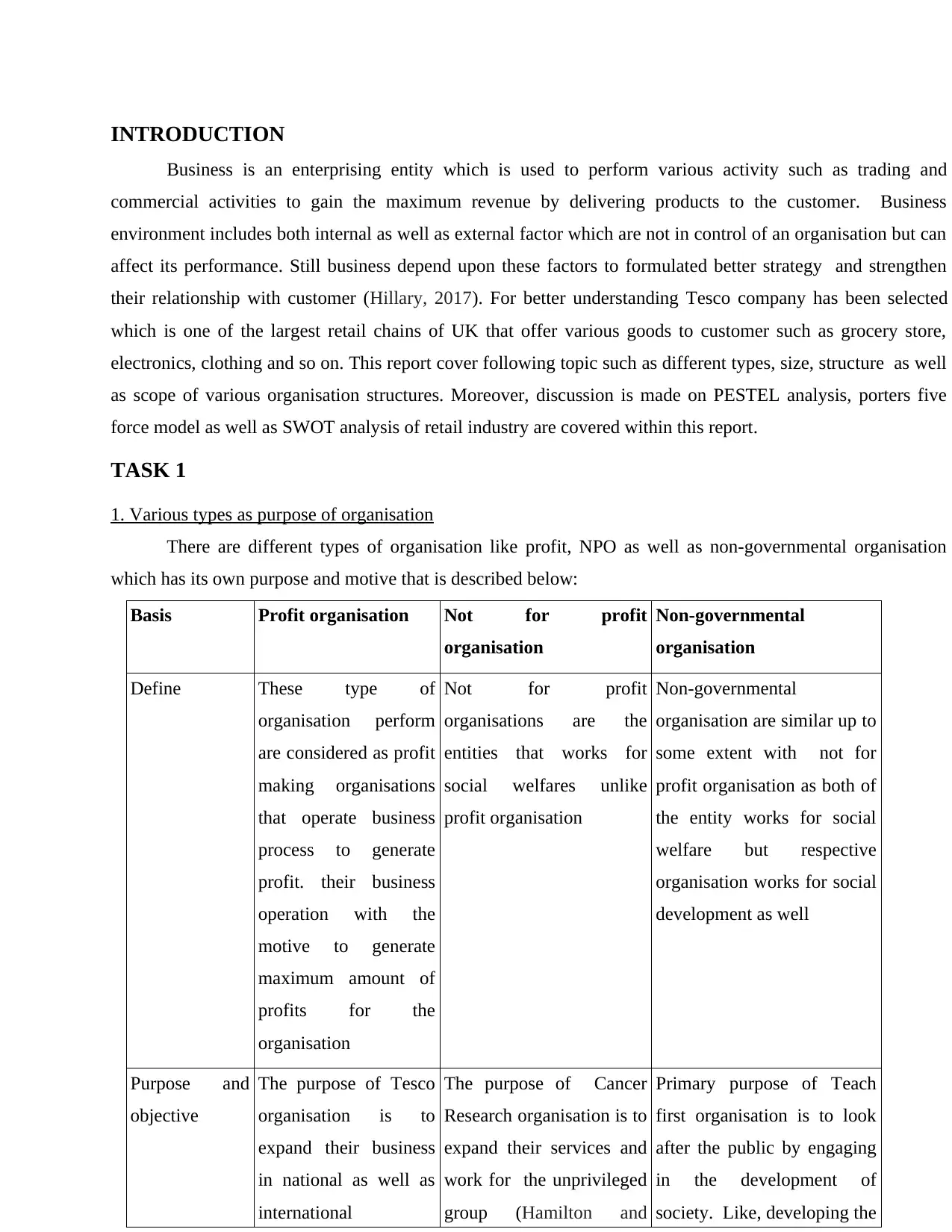
INTRODUCTION
Business is an enterprising entity which is used to perform various activity such as trading and
commercial activities to gain the maximum revenue by delivering products to the customer. Business
environment includes both internal as well as external factor which are not in control of an organisation but can
affect its performance. Still business depend upon these factors to formulated better strategy and strengthen
their relationship with customer (Hillary, 2017). For better understanding Tesco company has been selected
which is one of the largest retail chains of UK that offer various goods to customer such as grocery store,
electronics, clothing and so on. This report cover following topic such as different types, size, structure as well
as scope of various organisation structures. Moreover, discussion is made on PESTEL analysis, porters five
force model as well as SWOT analysis of retail industry are covered within this report.
TASK 1
1. Various types as purpose of organisation
There are different types of organisation like profit, NPO as well as non-governmental organisation
which has its own purpose and motive that is described below:
Basis Profit organisation Not for profit
organisation
Non-governmental
organisation
Define These type of
organisation perform
are considered as profit
making organisations
that operate business
process to generate
profit. their business
operation with the
motive to generate
maximum amount of
profits for the
organisation
Not for profit
organisations are the
entities that works for
social welfares unlike
profit organisation
Non-governmental
organisation are similar up to
some extent with not for
profit organisation as both of
the entity works for social
welfare but respective
organisation works for social
development as well
Purpose and
objective
The purpose of Tesco
organisation is to
expand their business
in national as well as
international
The purpose of Cancer
Research organisation is to
expand their services and
work for the unprivileged
group (Hamilton and
Primary purpose of Teach
first organisation is to look
after the public by engaging
in the development of
society. Like, developing the
Business is an enterprising entity which is used to perform various activity such as trading and
commercial activities to gain the maximum revenue by delivering products to the customer. Business
environment includes both internal as well as external factor which are not in control of an organisation but can
affect its performance. Still business depend upon these factors to formulated better strategy and strengthen
their relationship with customer (Hillary, 2017). For better understanding Tesco company has been selected
which is one of the largest retail chains of UK that offer various goods to customer such as grocery store,
electronics, clothing and so on. This report cover following topic such as different types, size, structure as well
as scope of various organisation structures. Moreover, discussion is made on PESTEL analysis, porters five
force model as well as SWOT analysis of retail industry are covered within this report.
TASK 1
1. Various types as purpose of organisation
There are different types of organisation like profit, NPO as well as non-governmental organisation
which has its own purpose and motive that is described below:
Basis Profit organisation Not for profit
organisation
Non-governmental
organisation
Define These type of
organisation perform
are considered as profit
making organisations
that operate business
process to generate
profit. their business
operation with the
motive to generate
maximum amount of
profits for the
organisation
Not for profit
organisations are the
entities that works for
social welfares unlike
profit organisation
Non-governmental
organisation are similar up to
some extent with not for
profit organisation as both of
the entity works for social
welfare but respective
organisation works for social
development as well
Purpose and
objective
The purpose of Tesco
organisation is to
expand their business
in national as well as
international
The purpose of Cancer
Research organisation is to
expand their services and
work for the unprivileged
group (Hamilton and
Primary purpose of Teach
first organisation is to look
after the public by engaging
in the development of
society. Like, developing the
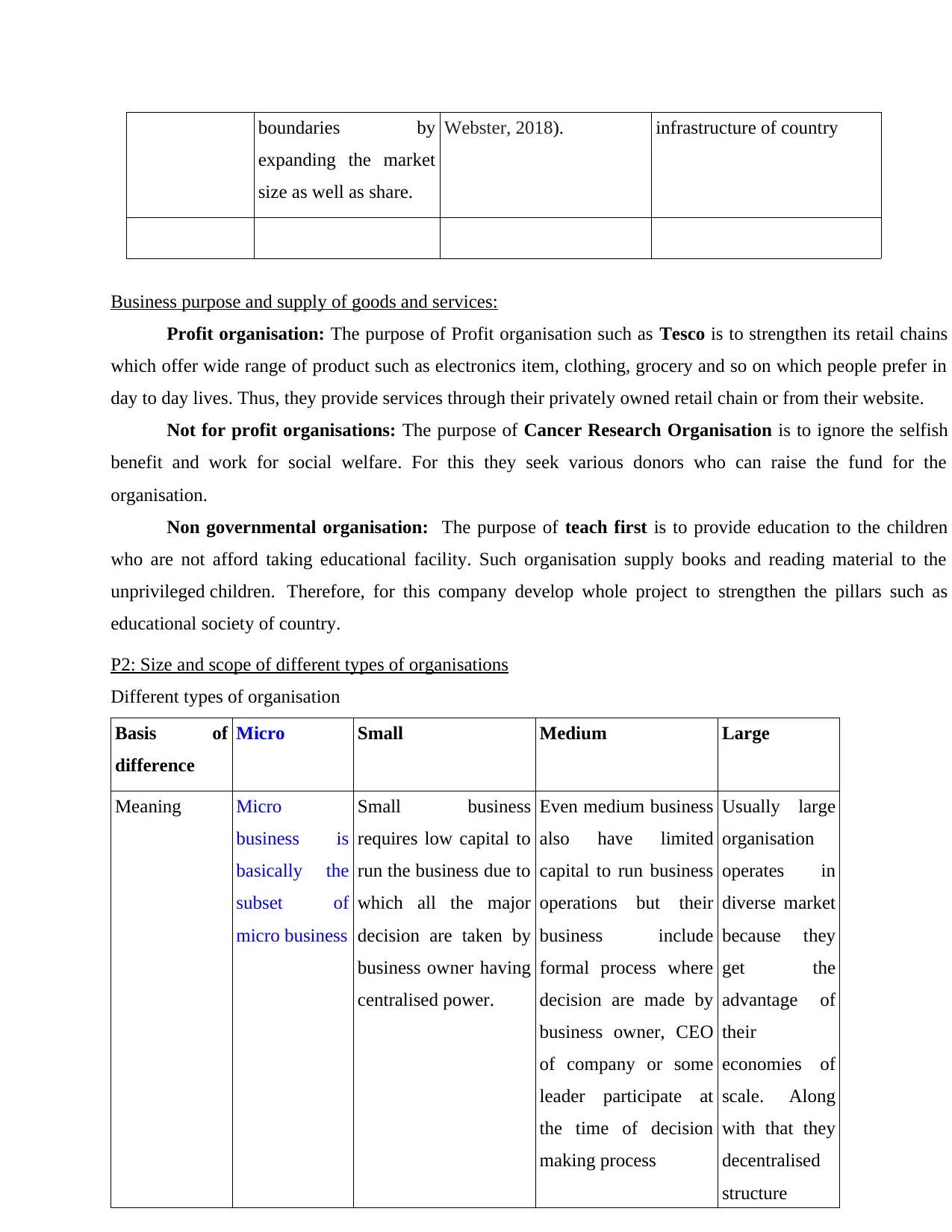
boundaries by
expanding the market
size as well as share.
Webster, 2018). infrastructure of country
Business purpose and supply of goods and services:
Profit organisation: The purpose of Profit organisation such as Tesco is to strengthen its retail chains
which offer wide range of product such as electronics item, clothing, grocery and so on which people prefer in
day to day lives. Thus, they provide services through their privately owned retail chain or from their website.
Not for profit organisations: The purpose of Cancer Research Organisation is to ignore the selfish
benefit and work for social welfare. For this they seek various donors who can raise the fund for the
organisation.
Non governmental organisation: The purpose of teach first is to provide education to the children
who are not afford taking educational facility. Such organisation supply books and reading material to the
unprivileged children. Therefore, for this company develop whole project to strengthen the pillars such as
educational society of country.
P2: Size and scope of different types of organisations
Different types of organisation
Basis of
difference
Micro Small Medium Large
Meaning Micro
business is
basically the
subset of
micro business
Small business
requires low capital to
run the business due to
which all the major
decision are taken by
business owner having
centralised power.
Even medium business
also have limited
capital to run business
operations but their
business include
formal process where
decision are made by
business owner, CEO
of company or some
leader participate at
the time of decision
making process
Usually large
organisation
operates in
diverse market
because they
get the
advantage of
their
economies of
scale. Along
with that they
decentralised
structure
expanding the market
size as well as share.
Webster, 2018). infrastructure of country
Business purpose and supply of goods and services:
Profit organisation: The purpose of Profit organisation such as Tesco is to strengthen its retail chains
which offer wide range of product such as electronics item, clothing, grocery and so on which people prefer in
day to day lives. Thus, they provide services through their privately owned retail chain or from their website.
Not for profit organisations: The purpose of Cancer Research Organisation is to ignore the selfish
benefit and work for social welfare. For this they seek various donors who can raise the fund for the
organisation.
Non governmental organisation: The purpose of teach first is to provide education to the children
who are not afford taking educational facility. Such organisation supply books and reading material to the
unprivileged children. Therefore, for this company develop whole project to strengthen the pillars such as
educational society of country.
P2: Size and scope of different types of organisations
Different types of organisation
Basis of
difference
Micro Small Medium Large
Meaning Micro
business is
basically the
subset of
micro business
Small business
requires low capital to
run the business due to
which all the major
decision are taken by
business owner having
centralised power.
Even medium business
also have limited
capital to run business
operations but their
business include
formal process where
decision are made by
business owner, CEO
of company or some
leader participate at
the time of decision
making process
Usually large
organisation
operates in
diverse market
because they
get the
advantage of
their
economies of
scale. Along
with that they
decentralised
structure
Secure Best Marks with AI Grader
Need help grading? Try our AI Grader for instant feedback on your assignments.
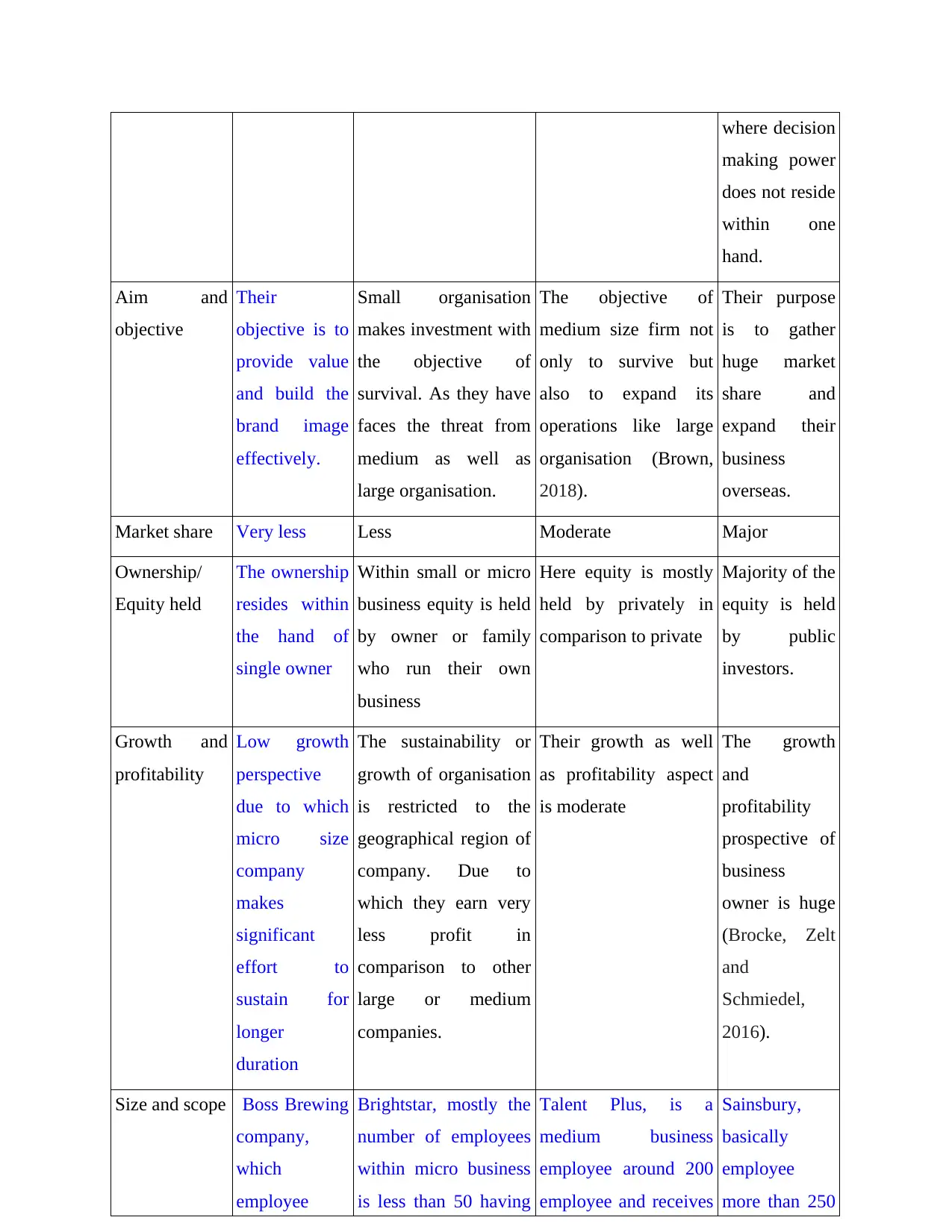
where decision
making power
does not reside
within one
hand.
Aim and
objective
Their
objective is to
provide value
and build the
brand image
effectively.
Small organisation
makes investment with
the objective of
survival. As they have
faces the threat from
medium as well as
large organisation.
The objective of
medium size firm not
only to survive but
also to expand its
operations like large
organisation (Brown,
2018).
Their purpose
is to gather
huge market
share and
expand their
business
overseas.
Market share Very less Less Moderate Major
Ownership/
Equity held
The ownership
resides within
the hand of
single owner
Within small or micro
business equity is held
by owner or family
who run their own
business
Here equity is mostly
held by privately in
comparison to private
Majority of the
equity is held
by public
investors.
Growth and
profitability
Low growth
perspective
due to which
micro size
company
makes
significant
effort to
sustain for
longer
duration
The sustainability or
growth of organisation
is restricted to the
geographical region of
company. Due to
which they earn very
less profit in
comparison to other
large or medium
companies.
Their growth as well
as profitability aspect
is moderate
The growth
and
profitability
prospective of
business
owner is huge
(Brocke, Zelt
and
Schmiedel,
2016).
Size and scope Boss Brewing
company,
which
employee
Brightstar, mostly the
number of employees
within micro business
is less than 50 having
Talent Plus, is a
medium business
employee around 200
employee and receives
Sainsbury,
basically
employee
more than 250
making power
does not reside
within one
hand.
Aim and
objective
Their
objective is to
provide value
and build the
brand image
effectively.
Small organisation
makes investment with
the objective of
survival. As they have
faces the threat from
medium as well as
large organisation.
The objective of
medium size firm not
only to survive but
also to expand its
operations like large
organisation (Brown,
2018).
Their purpose
is to gather
huge market
share and
expand their
business
overseas.
Market share Very less Less Moderate Major
Ownership/
Equity held
The ownership
resides within
the hand of
single owner
Within small or micro
business equity is held
by owner or family
who run their own
business
Here equity is mostly
held by privately in
comparison to private
Majority of the
equity is held
by public
investors.
Growth and
profitability
Low growth
perspective
due to which
micro size
company
makes
significant
effort to
sustain for
longer
duration
The sustainability or
growth of organisation
is restricted to the
geographical region of
company. Due to
which they earn very
less profit in
comparison to other
large or medium
companies.
Their growth as well
as profitability aspect
is moderate
The growth
and
profitability
prospective of
business
owner is huge
(Brocke, Zelt
and
Schmiedel,
2016).
Size and scope Boss Brewing
company,
which
employee
Brightstar, mostly the
number of employees
within micro business
is less than 50 having
Talent Plus, is a
medium business
employee around 200
employee and receives
Sainsbury,
basically
employee
more than 250

around 10
employee and
experience
revenue of
£3.5 million
turnover rate
approximately £6.5
million
turnover rate of £25.9
million.
employees and
experience
huge amount
of turnover
rate as well as
market share
in comparison
its small or
medium
business.
Market share, growth and sustainability
Size and scope of Tesco: Tesco is one of the largest retailers of world due to which it more than six
thousand stores which operate in more than ten countries including developing as well as developed country.
Thus, it provide employment to approximately five lac people all around the world further its market share is
27% which keeps on expanding. Additionally, they offer their services from their brick and mortar store as well
as on line platform. Hence, Tesco has adopted legal structure to run its operations successfully.
Public organisation:
Size and scope of Teach first: This organisation participate to provide education to that group who is
unprivileged to gain the education facility (Pearson, 2017). Moreover, it works for both primary as well as for
secondary schools due to which their size keeps on expanding. Currently, it has provided employment around
six hundred people for which company has followed the legal structure of central government.
Voluntary organisation:
Size and scope of Cancer Research: The role of cancer research voluntary organisation is to look after
the cancer patients. This is charity organisation that arrange funds from various to get the treatment of cancer
patients. There are various volunteers or fund raiser that is around thirty five thousand and employee of two
thousand who have attached with this organisation due to which their size with respect to revenue is around
£530.61.
3. Organisation structures and functions
The structures, size, scope, objective vary from one organisation to another depending upon the purpose
of existence thus, some of the structure are stated below:
Bureaucratic structure: This structure is usually adopted by small organisation where top level
management have decision making power which is used to control the operations of business (Hunter, Saunders
and Constance, 2016). For instance, ELM Tree hold or Airdri adopts bureaucratic structure.
employee and
experience
revenue of
£3.5 million
turnover rate
approximately £6.5
million
turnover rate of £25.9
million.
employees and
experience
huge amount
of turnover
rate as well as
market share
in comparison
its small or
medium
business.
Market share, growth and sustainability
Size and scope of Tesco: Tesco is one of the largest retailers of world due to which it more than six
thousand stores which operate in more than ten countries including developing as well as developed country.
Thus, it provide employment to approximately five lac people all around the world further its market share is
27% which keeps on expanding. Additionally, they offer their services from their brick and mortar store as well
as on line platform. Hence, Tesco has adopted legal structure to run its operations successfully.
Public organisation:
Size and scope of Teach first: This organisation participate to provide education to that group who is
unprivileged to gain the education facility (Pearson, 2017). Moreover, it works for both primary as well as for
secondary schools due to which their size keeps on expanding. Currently, it has provided employment around
six hundred people for which company has followed the legal structure of central government.
Voluntary organisation:
Size and scope of Cancer Research: The role of cancer research voluntary organisation is to look after
the cancer patients. This is charity organisation that arrange funds from various to get the treatment of cancer
patients. There are various volunteers or fund raiser that is around thirty five thousand and employee of two
thousand who have attached with this organisation due to which their size with respect to revenue is around
£530.61.
3. Organisation structures and functions
The structures, size, scope, objective vary from one organisation to another depending upon the purpose
of existence thus, some of the structure are stated below:
Bureaucratic structure: This structure is usually adopted by small organisation where top level
management have decision making power which is used to control the operations of business (Hunter, Saunders
and Constance, 2016). For instance, ELM Tree hold or Airdri adopts bureaucratic structure.
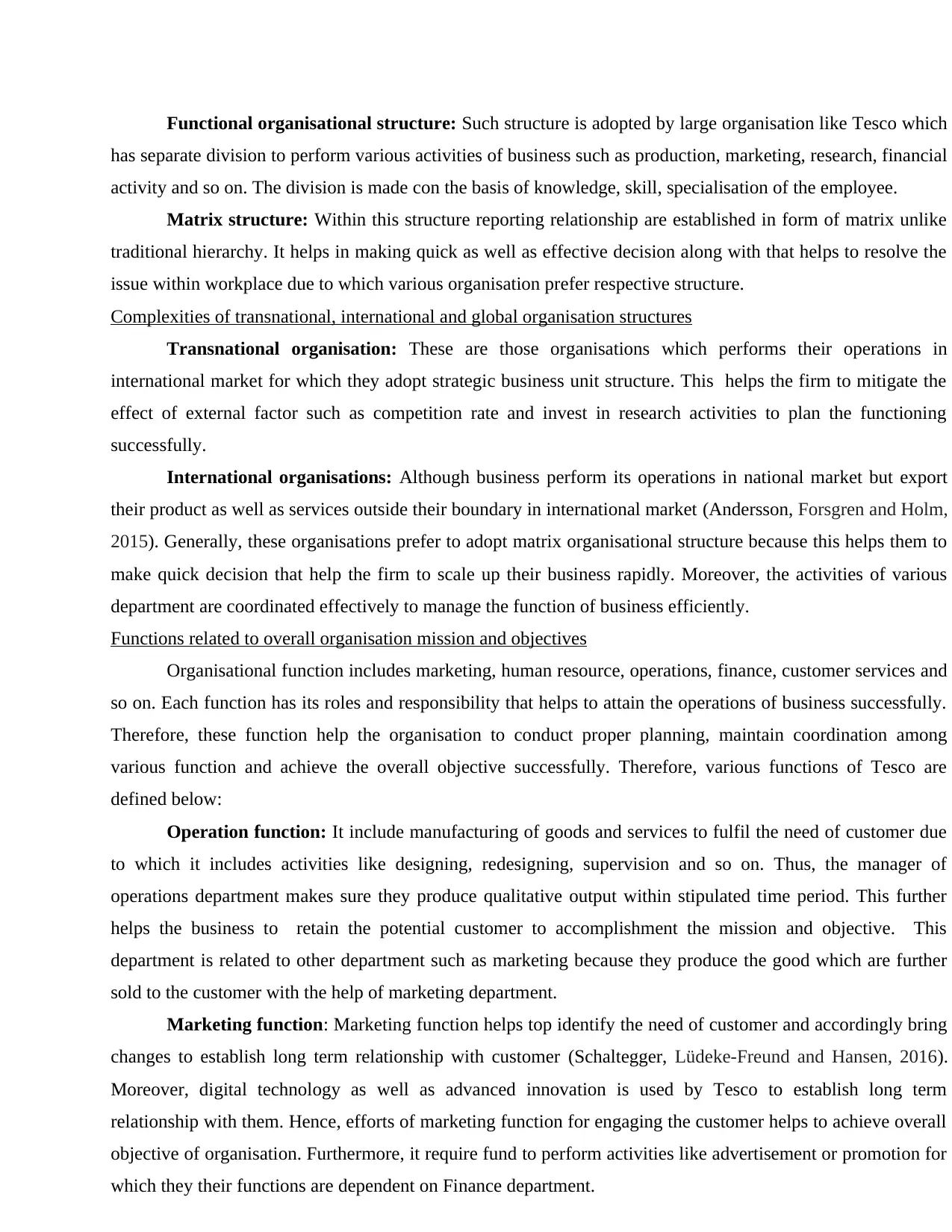
Functional organisational structure: Such structure is adopted by large organisation like Tesco which
has separate division to perform various activities of business such as production, marketing, research, financial
activity and so on. The division is made con the basis of knowledge, skill, specialisation of the employee.
Matrix structure: Within this structure reporting relationship are established in form of matrix unlike
traditional hierarchy. It helps in making quick as well as effective decision along with that helps to resolve the
issue within workplace due to which various organisation prefer respective structure.
Complexities of transnational, international and global organisation structures
Transnational organisation: These are those organisations which performs their operations in
international market for which they adopt strategic business unit structure. This helps the firm to mitigate the
effect of external factor such as competition rate and invest in research activities to plan the functioning
successfully.
International organisations: Although business perform its operations in national market but export
their product as well as services outside their boundary in international market (Andersson, Forsgren and Holm,
2015). Generally, these organisations prefer to adopt matrix organisational structure because this helps them to
make quick decision that help the firm to scale up their business rapidly. Moreover, the activities of various
department are coordinated effectively to manage the function of business efficiently.
Functions related to overall organisation mission and objectives
Organisational function includes marketing, human resource, operations, finance, customer services and
so on. Each function has its roles and responsibility that helps to attain the operations of business successfully.
Therefore, these function help the organisation to conduct proper planning, maintain coordination among
various function and achieve the overall objective successfully. Therefore, various functions of Tesco are
defined below:
Operation function: It include manufacturing of goods and services to fulfil the need of customer due
to which it includes activities like designing, redesigning, supervision and so on. Thus, the manager of
operations department makes sure they produce qualitative output within stipulated time period. This further
helps the business to retain the potential customer to accomplishment the mission and objective. This
department is related to other department such as marketing because they produce the good which are further
sold to the customer with the help of marketing department.
Marketing function: Marketing function helps top identify the need of customer and accordingly bring
changes to establish long term relationship with customer (Schaltegger, Lüdeke-Freund and Hansen, 2016).
Moreover, digital technology as well as advanced innovation is used by Tesco to establish long term
relationship with them. Hence, efforts of marketing function for engaging the customer helps to achieve overall
objective of organisation. Furthermore, it require fund to perform activities like advertisement or promotion for
which they their functions are dependent on Finance department.
has separate division to perform various activities of business such as production, marketing, research, financial
activity and so on. The division is made con the basis of knowledge, skill, specialisation of the employee.
Matrix structure: Within this structure reporting relationship are established in form of matrix unlike
traditional hierarchy. It helps in making quick as well as effective decision along with that helps to resolve the
issue within workplace due to which various organisation prefer respective structure.
Complexities of transnational, international and global organisation structures
Transnational organisation: These are those organisations which performs their operations in
international market for which they adopt strategic business unit structure. This helps the firm to mitigate the
effect of external factor such as competition rate and invest in research activities to plan the functioning
successfully.
International organisations: Although business perform its operations in national market but export
their product as well as services outside their boundary in international market (Andersson, Forsgren and Holm,
2015). Generally, these organisations prefer to adopt matrix organisational structure because this helps them to
make quick decision that help the firm to scale up their business rapidly. Moreover, the activities of various
department are coordinated effectively to manage the function of business efficiently.
Functions related to overall organisation mission and objectives
Organisational function includes marketing, human resource, operations, finance, customer services and
so on. Each function has its roles and responsibility that helps to attain the operations of business successfully.
Therefore, these function help the organisation to conduct proper planning, maintain coordination among
various function and achieve the overall objective successfully. Therefore, various functions of Tesco are
defined below:
Operation function: It include manufacturing of goods and services to fulfil the need of customer due
to which it includes activities like designing, redesigning, supervision and so on. Thus, the manager of
operations department makes sure they produce qualitative output within stipulated time period. This further
helps the business to retain the potential customer to accomplishment the mission and objective. This
department is related to other department such as marketing because they produce the good which are further
sold to the customer with the help of marketing department.
Marketing function: Marketing function helps top identify the need of customer and accordingly bring
changes to establish long term relationship with customer (Schaltegger, Lüdeke-Freund and Hansen, 2016).
Moreover, digital technology as well as advanced innovation is used by Tesco to establish long term
relationship with them. Hence, efforts of marketing function for engaging the customer helps to achieve overall
objective of organisation. Furthermore, it require fund to perform activities like advertisement or promotion for
which they their functions are dependent on Finance department.
Paraphrase This Document
Need a fresh take? Get an instant paraphrase of this document with our AI Paraphraser
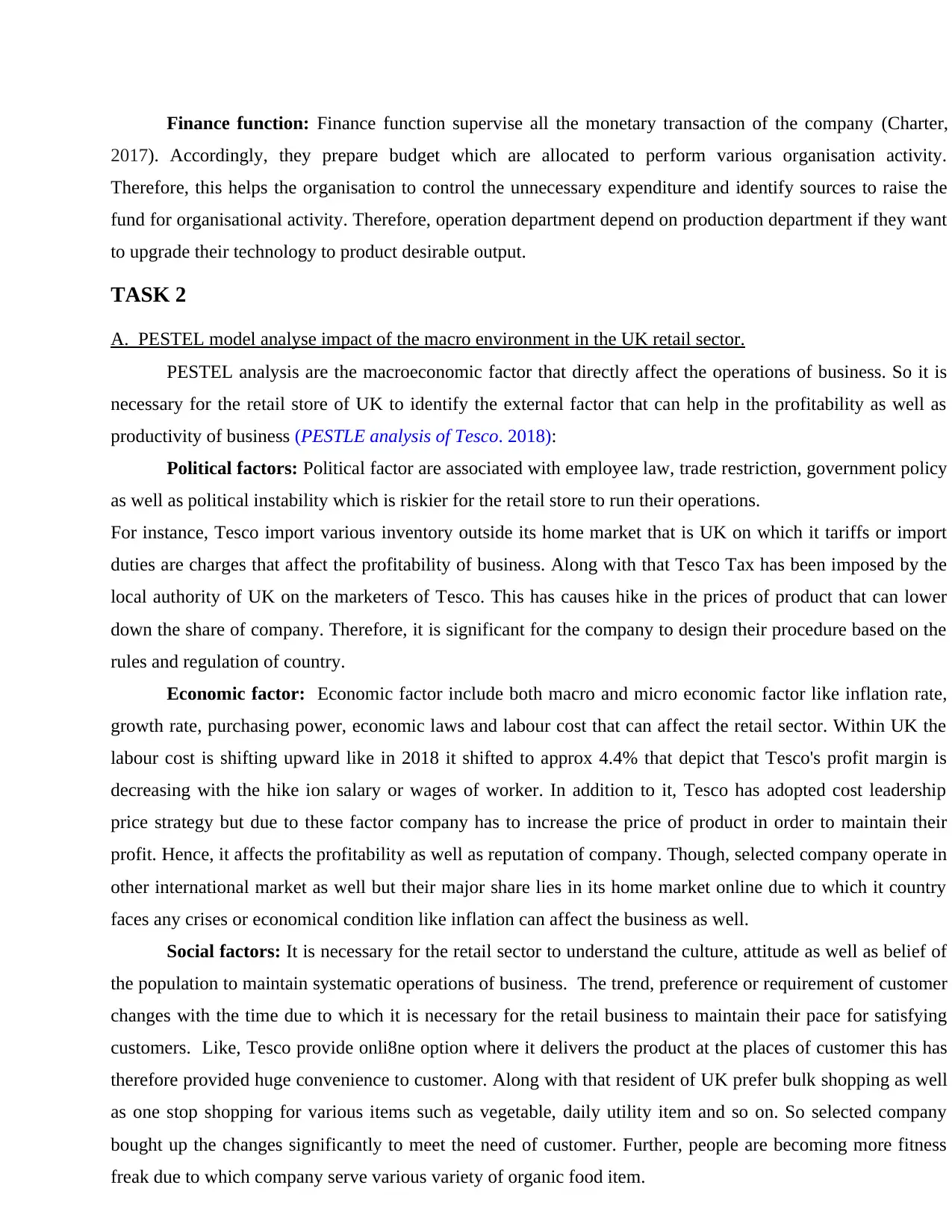
Finance function: Finance function supervise all the monetary transaction of the company (Charter,
2017). Accordingly, they prepare budget which are allocated to perform various organisation activity.
Therefore, this helps the organisation to control the unnecessary expenditure and identify sources to raise the
fund for organisational activity. Therefore, operation department depend on production department if they want
to upgrade their technology to product desirable output.
TASK 2
A. PESTEL model analyse impact of the macro environment in the UK retail sector.
PESTEL analysis are the macroeconomic factor that directly affect the operations of business. So it is
necessary for the retail store of UK to identify the external factor that can help in the profitability as well as
productivity of business (PESTLE analysis of Tesco. 2018):
Political factors: Political factor are associated with employee law, trade restriction, government policy
as well as political instability which is riskier for the retail store to run their operations.
For instance, Tesco import various inventory outside its home market that is UK on which it tariffs or import
duties are charges that affect the profitability of business. Along with that Tesco Tax has been imposed by the
local authority of UK on the marketers of Tesco. This has causes hike in the prices of product that can lower
down the share of company. Therefore, it is significant for the company to design their procedure based on the
rules and regulation of country.
Economic factor: Economic factor include both macro and micro economic factor like inflation rate,
growth rate, purchasing power, economic laws and labour cost that can affect the retail sector. Within UK the
labour cost is shifting upward like in 2018 it shifted to approx 4.4% that depict that Tesco's profit margin is
decreasing with the hike ion salary or wages of worker. In addition to it, Tesco has adopted cost leadership
price strategy but due to these factor company has to increase the price of product in order to maintain their
profit. Hence, it affects the profitability as well as reputation of company. Though, selected company operate in
other international market as well but their major share lies in its home market online due to which it country
faces any crises or economical condition like inflation can affect the business as well.
Social factors: It is necessary for the retail sector to understand the culture, attitude as well as belief of
the population to maintain systematic operations of business. The trend, preference or requirement of customer
changes with the time due to which it is necessary for the retail business to maintain their pace for satisfying
customers. Like, Tesco provide onli8ne option where it delivers the product at the places of customer this has
therefore provided huge convenience to customer. Along with that resident of UK prefer bulk shopping as well
as one stop shopping for various items such as vegetable, daily utility item and so on. So selected company
bought up the changes significantly to meet the need of customer. Further, people are becoming more fitness
freak due to which company serve various variety of organic food item.
2017). Accordingly, they prepare budget which are allocated to perform various organisation activity.
Therefore, this helps the organisation to control the unnecessary expenditure and identify sources to raise the
fund for organisational activity. Therefore, operation department depend on production department if they want
to upgrade their technology to product desirable output.
TASK 2
A. PESTEL model analyse impact of the macro environment in the UK retail sector.
PESTEL analysis are the macroeconomic factor that directly affect the operations of business. So it is
necessary for the retail store of UK to identify the external factor that can help in the profitability as well as
productivity of business (PESTLE analysis of Tesco. 2018):
Political factors: Political factor are associated with employee law, trade restriction, government policy
as well as political instability which is riskier for the retail store to run their operations.
For instance, Tesco import various inventory outside its home market that is UK on which it tariffs or import
duties are charges that affect the profitability of business. Along with that Tesco Tax has been imposed by the
local authority of UK on the marketers of Tesco. This has causes hike in the prices of product that can lower
down the share of company. Therefore, it is significant for the company to design their procedure based on the
rules and regulation of country.
Economic factor: Economic factor include both macro and micro economic factor like inflation rate,
growth rate, purchasing power, economic laws and labour cost that can affect the retail sector. Within UK the
labour cost is shifting upward like in 2018 it shifted to approx 4.4% that depict that Tesco's profit margin is
decreasing with the hike ion salary or wages of worker. In addition to it, Tesco has adopted cost leadership
price strategy but due to these factor company has to increase the price of product in order to maintain their
profit. Hence, it affects the profitability as well as reputation of company. Though, selected company operate in
other international market as well but their major share lies in its home market online due to which it country
faces any crises or economical condition like inflation can affect the business as well.
Social factors: It is necessary for the retail sector to understand the culture, attitude as well as belief of
the population to maintain systematic operations of business. The trend, preference or requirement of customer
changes with the time due to which it is necessary for the retail business to maintain their pace for satisfying
customers. Like, Tesco provide onli8ne option where it delivers the product at the places of customer this has
therefore provided huge convenience to customer. Along with that resident of UK prefer bulk shopping as well
as one stop shopping for various items such as vegetable, daily utility item and so on. So selected company
bought up the changes significantly to meet the need of customer. Further, people are becoming more fitness
freak due to which company serve various variety of organic food item.
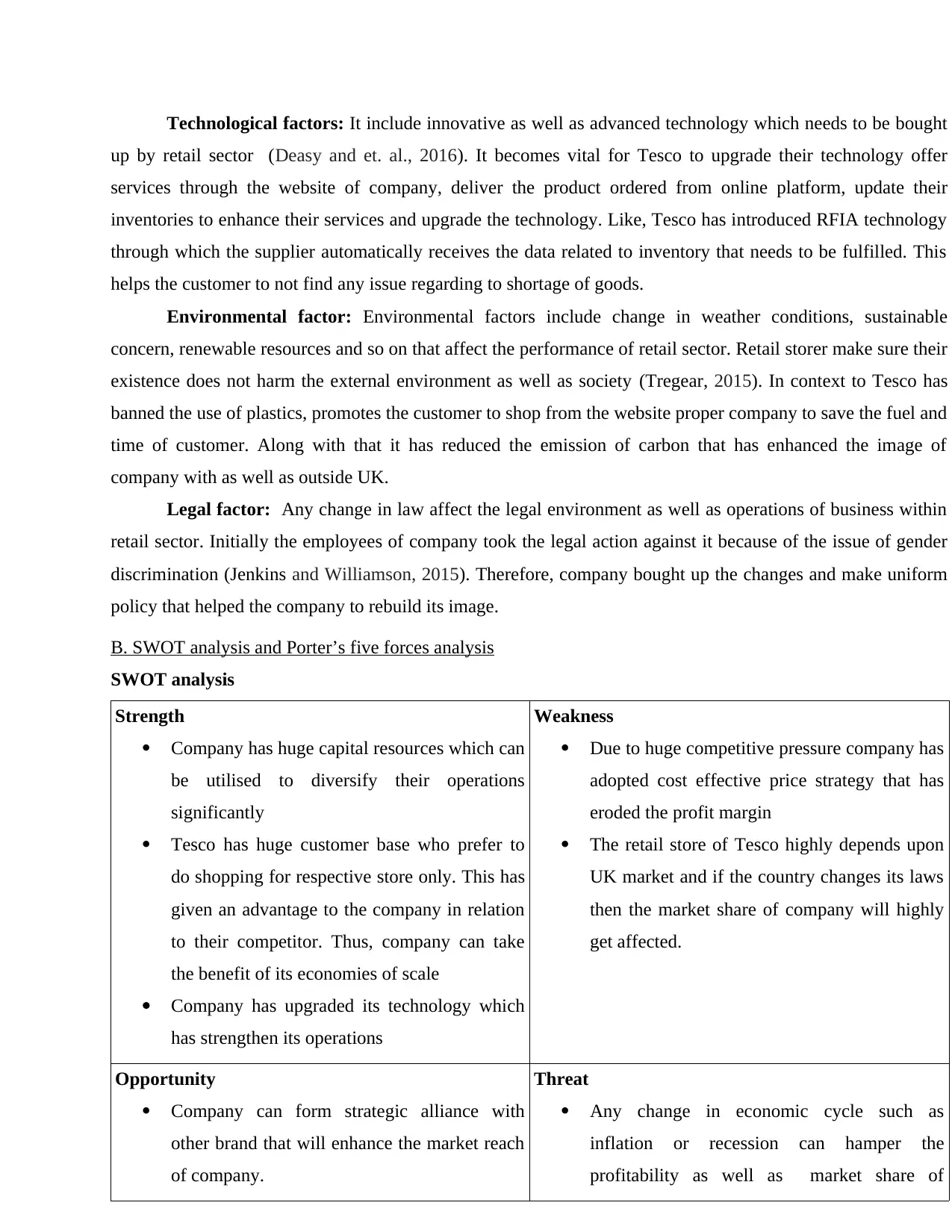
Technological factors: It include innovative as well as advanced technology which needs to be bought
up by retail sector (Deasy and et. al., 2016). It becomes vital for Tesco to upgrade their technology offer
services through the website of company, deliver the product ordered from online platform, update their
inventories to enhance their services and upgrade the technology. Like, Tesco has introduced RFIA technology
through which the supplier automatically receives the data related to inventory that needs to be fulfilled. This
helps the customer to not find any issue regarding to shortage of goods.
Environmental factor: Environmental factors include change in weather conditions, sustainable
concern, renewable resources and so on that affect the performance of retail sector. Retail storer make sure their
existence does not harm the external environment as well as society (Tregear, 2015). In context to Tesco has
banned the use of plastics, promotes the customer to shop from the website proper company to save the fuel and
time of customer. Along with that it has reduced the emission of carbon that has enhanced the image of
company with as well as outside UK.
Legal factor: Any change in law affect the legal environment as well as operations of business within
retail sector. Initially the employees of company took the legal action against it because of the issue of gender
discrimination (Jenkins and Williamson, 2015). Therefore, company bought up the changes and make uniform
policy that helped the company to rebuild its image.
B. SWOT analysis and Porter’s five forces analysis
SWOT analysis
Strength
Company has huge capital resources which can
be utilised to diversify their operations
significantly
Tesco has huge customer base who prefer to
do shopping for respective store only. This has
given an advantage to the company in relation
to their competitor. Thus, company can take
the benefit of its economies of scale
Company has upgraded its technology which
has strengthen its operations
Weakness
Due to huge competitive pressure company has
adopted cost effective price strategy that has
eroded the profit margin
The retail store of Tesco highly depends upon
UK market and if the country changes its laws
then the market share of company will highly
get affected.
Opportunity
Company can form strategic alliance with
other brand that will enhance the market reach
of company.
Threat
Any change in economic cycle such as
inflation or recession can hamper the
profitability as well as market share of
up by retail sector (Deasy and et. al., 2016). It becomes vital for Tesco to upgrade their technology offer
services through the website of company, deliver the product ordered from online platform, update their
inventories to enhance their services and upgrade the technology. Like, Tesco has introduced RFIA technology
through which the supplier automatically receives the data related to inventory that needs to be fulfilled. This
helps the customer to not find any issue regarding to shortage of goods.
Environmental factor: Environmental factors include change in weather conditions, sustainable
concern, renewable resources and so on that affect the performance of retail sector. Retail storer make sure their
existence does not harm the external environment as well as society (Tregear, 2015). In context to Tesco has
banned the use of plastics, promotes the customer to shop from the website proper company to save the fuel and
time of customer. Along with that it has reduced the emission of carbon that has enhanced the image of
company with as well as outside UK.
Legal factor: Any change in law affect the legal environment as well as operations of business within
retail sector. Initially the employees of company took the legal action against it because of the issue of gender
discrimination (Jenkins and Williamson, 2015). Therefore, company bought up the changes and make uniform
policy that helped the company to rebuild its image.
B. SWOT analysis and Porter’s five forces analysis
SWOT analysis
Strength
Company has huge capital resources which can
be utilised to diversify their operations
significantly
Tesco has huge customer base who prefer to
do shopping for respective store only. This has
given an advantage to the company in relation
to their competitor. Thus, company can take
the benefit of its economies of scale
Company has upgraded its technology which
has strengthen its operations
Weakness
Due to huge competitive pressure company has
adopted cost effective price strategy that has
eroded the profit margin
The retail store of Tesco highly depends upon
UK market and if the country changes its laws
then the market share of company will highly
get affected.
Opportunity
Company can form strategic alliance with
other brand that will enhance the market reach
of company.
Threat
Any change in economic cycle such as
inflation or recession can hamper the
profitability as well as market share of
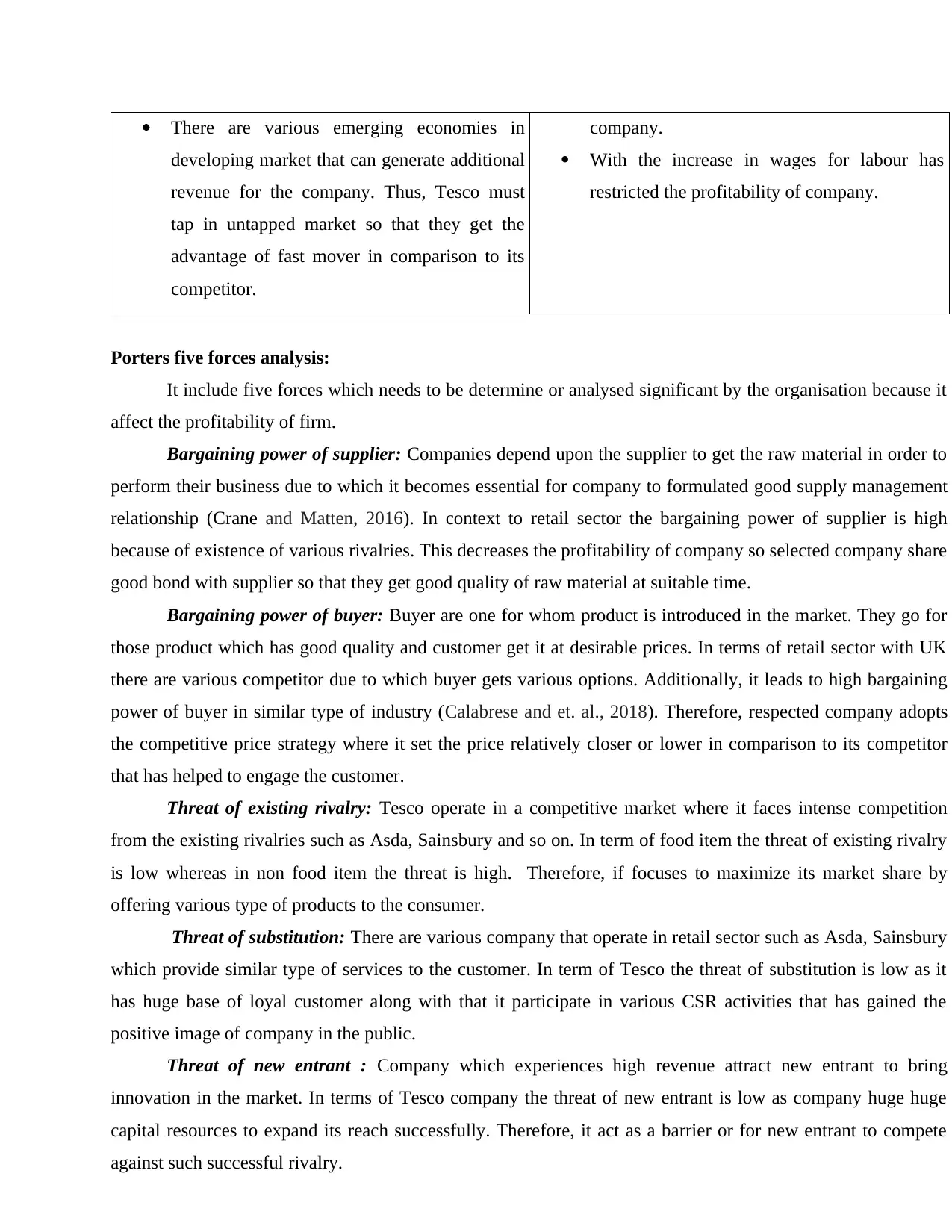
There are various emerging economies in
developing market that can generate additional
revenue for the company. Thus, Tesco must
tap in untapped market so that they get the
advantage of fast mover in comparison to its
competitor.
company.
With the increase in wages for labour has
restricted the profitability of company.
Porters five forces analysis:
It include five forces which needs to be determine or analysed significant by the organisation because it
affect the profitability of firm.
Bargaining power of supplier: Companies depend upon the supplier to get the raw material in order to
perform their business due to which it becomes essential for company to formulated good supply management
relationship (Crane and Matten, 2016). In context to retail sector the bargaining power of supplier is high
because of existence of various rivalries. This decreases the profitability of company so selected company share
good bond with supplier so that they get good quality of raw material at suitable time.
Bargaining power of buyer: Buyer are one for whom product is introduced in the market. They go for
those product which has good quality and customer get it at desirable prices. In terms of retail sector with UK
there are various competitor due to which buyer gets various options. Additionally, it leads to high bargaining
power of buyer in similar type of industry (Calabrese and et. al., 2018). Therefore, respected company adopts
the competitive price strategy where it set the price relatively closer or lower in comparison to its competitor
that has helped to engage the customer.
Threat of existing rivalry: Tesco operate in a competitive market where it faces intense competition
from the existing rivalries such as Asda, Sainsbury and so on. In term of food item the threat of existing rivalry
is low whereas in non food item the threat is high. Therefore, if focuses to maximize its market share by
offering various type of products to the consumer.
Threat of substitution: There are various company that operate in retail sector such as Asda, Sainsbury
which provide similar type of services to the customer. In term of Tesco the threat of substitution is low as it
has huge base of loyal customer along with that it participate in various CSR activities that has gained the
positive image of company in the public.
Threat of new entrant : Company which experiences high revenue attract new entrant to bring
innovation in the market. In terms of Tesco company the threat of new entrant is low as company huge huge
capital resources to expand its reach successfully. Therefore, it act as a barrier or for new entrant to compete
against such successful rivalry.
developing market that can generate additional
revenue for the company. Thus, Tesco must
tap in untapped market so that they get the
advantage of fast mover in comparison to its
competitor.
company.
With the increase in wages for labour has
restricted the profitability of company.
Porters five forces analysis:
It include five forces which needs to be determine or analysed significant by the organisation because it
affect the profitability of firm.
Bargaining power of supplier: Companies depend upon the supplier to get the raw material in order to
perform their business due to which it becomes essential for company to formulated good supply management
relationship (Crane and Matten, 2016). In context to retail sector the bargaining power of supplier is high
because of existence of various rivalries. This decreases the profitability of company so selected company share
good bond with supplier so that they get good quality of raw material at suitable time.
Bargaining power of buyer: Buyer are one for whom product is introduced in the market. They go for
those product which has good quality and customer get it at desirable prices. In terms of retail sector with UK
there are various competitor due to which buyer gets various options. Additionally, it leads to high bargaining
power of buyer in similar type of industry (Calabrese and et. al., 2018). Therefore, respected company adopts
the competitive price strategy where it set the price relatively closer or lower in comparison to its competitor
that has helped to engage the customer.
Threat of existing rivalry: Tesco operate in a competitive market where it faces intense competition
from the existing rivalries such as Asda, Sainsbury and so on. In term of food item the threat of existing rivalry
is low whereas in non food item the threat is high. Therefore, if focuses to maximize its market share by
offering various type of products to the consumer.
Threat of substitution: There are various company that operate in retail sector such as Asda, Sainsbury
which provide similar type of services to the customer. In term of Tesco the threat of substitution is low as it
has huge base of loyal customer along with that it participate in various CSR activities that has gained the
positive image of company in the public.
Threat of new entrant : Company which experiences high revenue attract new entrant to bring
innovation in the market. In terms of Tesco company the threat of new entrant is low as company huge huge
capital resources to expand its reach successfully. Therefore, it act as a barrier or for new entrant to compete
against such successful rivalry.
Secure Best Marks with AI Grader
Need help grading? Try our AI Grader for instant feedback on your assignments.
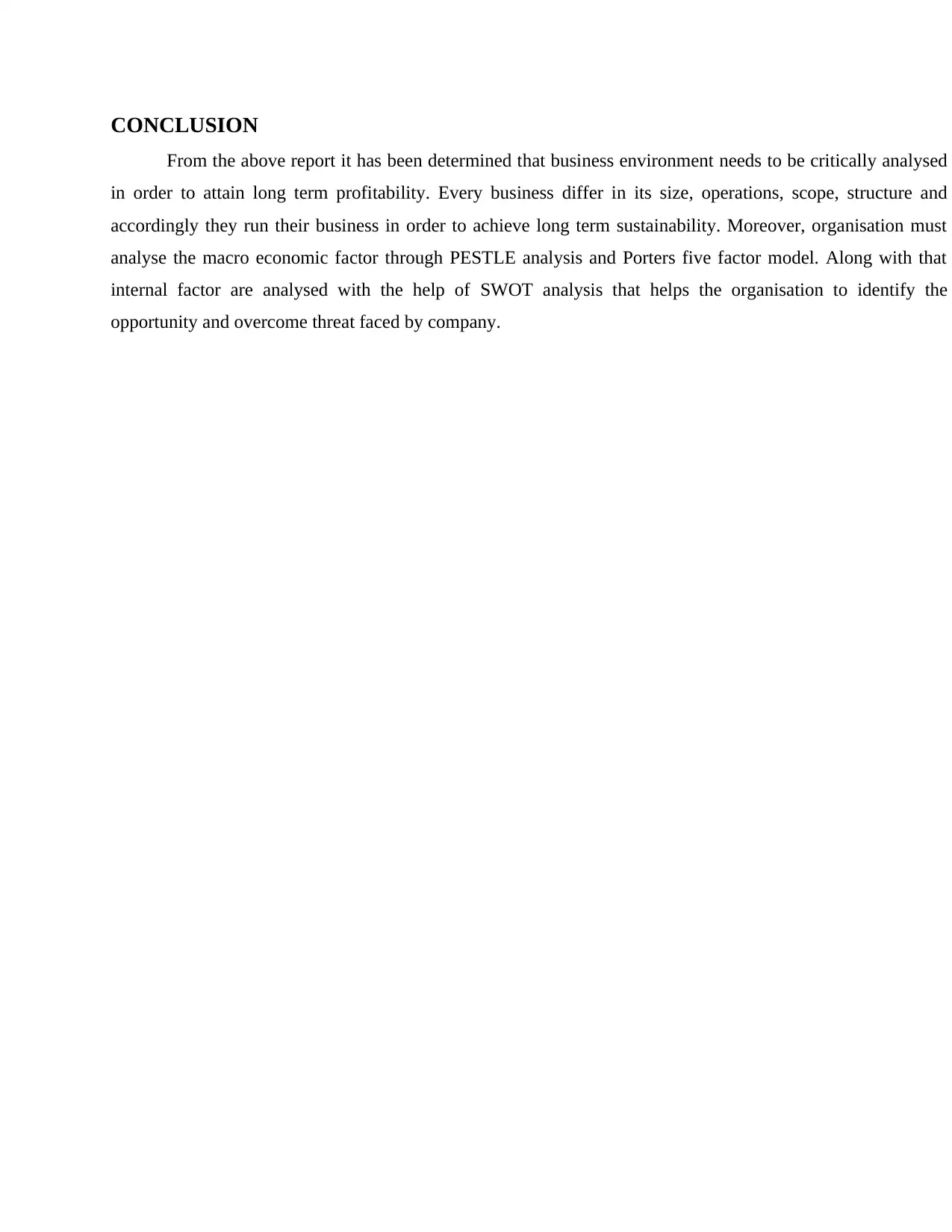
CONCLUSION
From the above report it has been determined that business environment needs to be critically analysed
in order to attain long term profitability. Every business differ in its size, operations, scope, structure and
accordingly they run their business in order to achieve long term sustainability. Moreover, organisation must
analyse the macro economic factor through PESTLE analysis and Porters five factor model. Along with that
internal factor are analysed with the help of SWOT analysis that helps the organisation to identify the
opportunity and overcome threat faced by company.
From the above report it has been determined that business environment needs to be critically analysed
in order to attain long term profitability. Every business differ in its size, operations, scope, structure and
accordingly they run their business in order to achieve long term sustainability. Moreover, organisation must
analyse the macro economic factor through PESTLE analysis and Porters five factor model. Along with that
internal factor are analysed with the help of SWOT analysis that helps the organisation to identify the
opportunity and overcome threat faced by company.
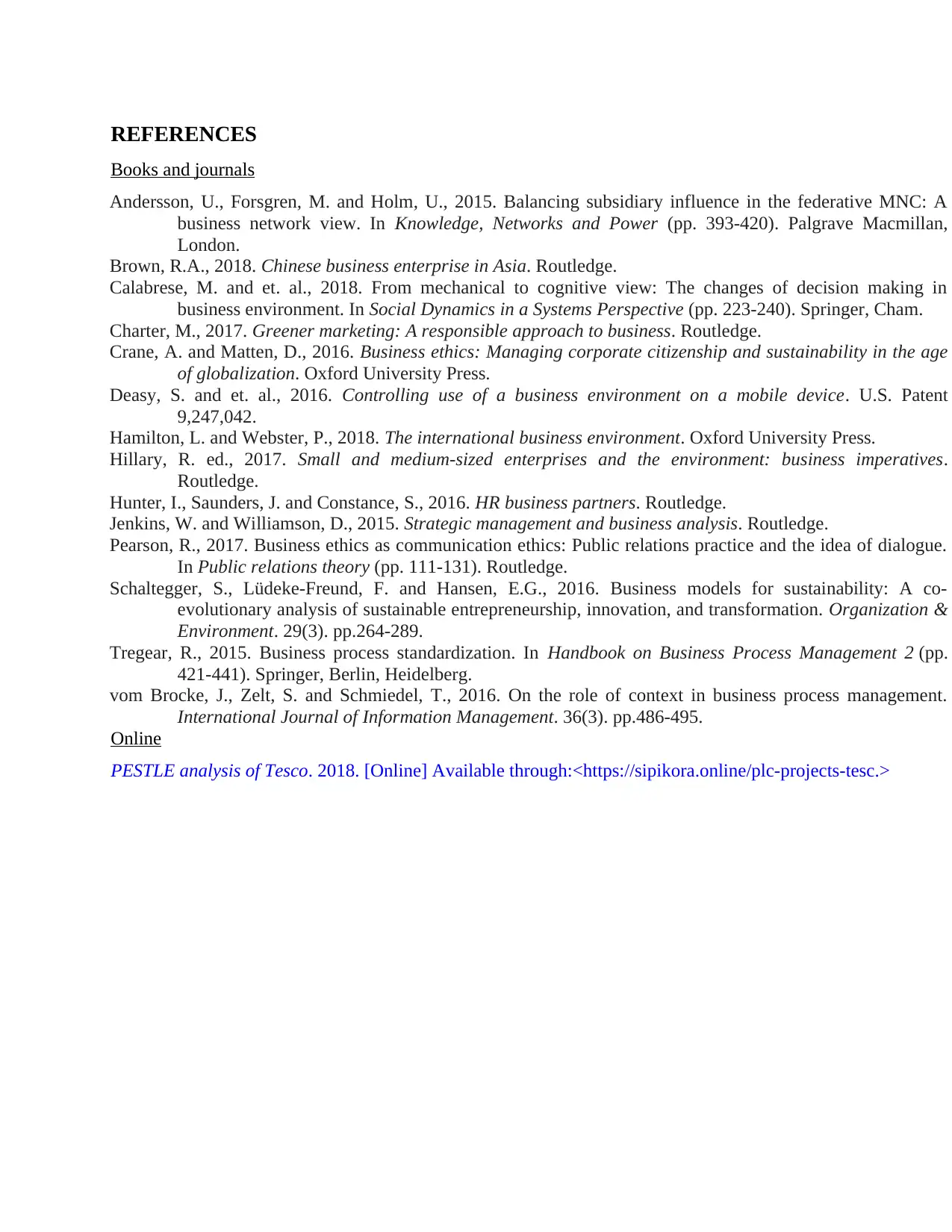
REFERENCES
Books and journals
Andersson, U., Forsgren, M. and Holm, U., 2015. Balancing subsidiary influence in the federative MNC: A
business network view. In Knowledge, Networks and Power (pp. 393-420). Palgrave Macmillan,
London.
Brown, R.A., 2018. Chinese business enterprise in Asia. Routledge.
Calabrese, M. and et. al., 2018. From mechanical to cognitive view: The changes of decision making in
business environment. In Social Dynamics in a Systems Perspective (pp. 223-240). Springer, Cham.
Charter, M., 2017. Greener marketing: A responsible approach to business. Routledge.
Crane, A. and Matten, D., 2016. Business ethics: Managing corporate citizenship and sustainability in the age
of globalization. Oxford University Press.
Deasy, S. and et. al., 2016. Controlling use of a business environment on a mobile device. U.S. Patent
9,247,042.
Hamilton, L. and Webster, P., 2018. The international business environment. Oxford University Press.
Hillary, R. ed., 2017. Small and medium-sized enterprises and the environment: business imperatives.
Routledge.
Hunter, I., Saunders, J. and Constance, S., 2016. HR business partners. Routledge.
Jenkins, W. and Williamson, D., 2015. Strategic management and business analysis. Routledge.
Pearson, R., 2017. Business ethics as communication ethics: Public relations practice and the idea of dialogue.
In Public relations theory (pp. 111-131). Routledge.
Schaltegger, S., Lüdeke-Freund, F. and Hansen, E.G., 2016. Business models for sustainability: A co-
evolutionary analysis of sustainable entrepreneurship, innovation, and transformation. Organization &
Environment. 29(3). pp.264-289.
Tregear, R., 2015. Business process standardization. In Handbook on Business Process Management 2 (pp.
421-441). Springer, Berlin, Heidelberg.
vom Brocke, J., Zelt, S. and Schmiedel, T., 2016. On the role of context in business process management.
International Journal of Information Management. 36(3). pp.486-495.
Online
PESTLE analysis of Tesco. 2018. [Online] Available through:<https://sipikora.online/plc-projects-tesc.>
Books and journals
Andersson, U., Forsgren, M. and Holm, U., 2015. Balancing subsidiary influence in the federative MNC: A
business network view. In Knowledge, Networks and Power (pp. 393-420). Palgrave Macmillan,
London.
Brown, R.A., 2018. Chinese business enterprise in Asia. Routledge.
Calabrese, M. and et. al., 2018. From mechanical to cognitive view: The changes of decision making in
business environment. In Social Dynamics in a Systems Perspective (pp. 223-240). Springer, Cham.
Charter, M., 2017. Greener marketing: A responsible approach to business. Routledge.
Crane, A. and Matten, D., 2016. Business ethics: Managing corporate citizenship and sustainability in the age
of globalization. Oxford University Press.
Deasy, S. and et. al., 2016. Controlling use of a business environment on a mobile device. U.S. Patent
9,247,042.
Hamilton, L. and Webster, P., 2018. The international business environment. Oxford University Press.
Hillary, R. ed., 2017. Small and medium-sized enterprises and the environment: business imperatives.
Routledge.
Hunter, I., Saunders, J. and Constance, S., 2016. HR business partners. Routledge.
Jenkins, W. and Williamson, D., 2015. Strategic management and business analysis. Routledge.
Pearson, R., 2017. Business ethics as communication ethics: Public relations practice and the idea of dialogue.
In Public relations theory (pp. 111-131). Routledge.
Schaltegger, S., Lüdeke-Freund, F. and Hansen, E.G., 2016. Business models for sustainability: A co-
evolutionary analysis of sustainable entrepreneurship, innovation, and transformation. Organization &
Environment. 29(3). pp.264-289.
Tregear, R., 2015. Business process standardization. In Handbook on Business Process Management 2 (pp.
421-441). Springer, Berlin, Heidelberg.
vom Brocke, J., Zelt, S. and Schmiedel, T., 2016. On the role of context in business process management.
International Journal of Information Management. 36(3). pp.486-495.
Online
PESTLE analysis of Tesco. 2018. [Online] Available through:<https://sipikora.online/plc-projects-tesc.>
1 out of 12
Related Documents
Your All-in-One AI-Powered Toolkit for Academic Success.
+13062052269
info@desklib.com
Available 24*7 on WhatsApp / Email
![[object Object]](/_next/static/media/star-bottom.7253800d.svg)
Unlock your academic potential
© 2024 | Zucol Services PVT LTD | All rights reserved.





